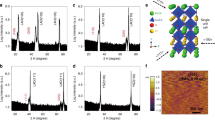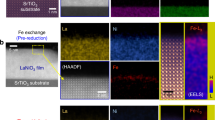Abstract
Engineering material structures at the atomic level is a promising way to tune the physicochemical properties of materials and optimize their performance in various potential applications. Here, we show that the lithiation-induced amorphization of layered crystalline Pd3P2S8 activates this otherwise electrochemically inert material as a highly efficient hydrogen evolution catalyst. Electrochemical lithiation of the layered Pd3P2S8 crystal results in the formation of amorphous lithium-incorporated palladium phosphosulfide nanodots with abundant vacancies. The structure change during the lithiation-induced amorphization process is investigated in detail. The amorphous lithium-incorporated palladium phosphosulfide nanodots exhibit excellent electrocatalytic activity towards the hydrogen evolution reaction with an onset potential of −52 mV, a Tafel slope of 29 mV dec−1 and outstanding long-term stability. Experimental and theoretical investigations reveal that the tuning of morphology and structure of Pd3P2S8 (for example, dimension decrease, crystallinity loss, vacancy formation and lithium incorporation) contribute to the activation of its intrinsically inert electrocatalytic property. This work provides a unique way for structure tuning of a material to effectively manipulate its catalytic properties and functionalities.
This is a preview of subscription content, access via your institution
Access options
Access Nature and 54 other Nature Portfolio journals
Get Nature+, our best-value online-access subscription
$29.99 / 30 days
cancel any time
Subscribe to this journal
Receive 12 digital issues and online access to articles
$119.00 per year
only $9.92 per issue
Buy this article
- Purchase on Springer Link
- Instant access to full article PDF
Prices may be subject to local taxes which are calculated during checkout




Similar content being viewed by others
References
Seh, Z. W. et al. Combining theory and experiment in electrocatalysis: insights into materials design. Science 355, 146 (2017).
Wang, H., Yuan, H., Sae Hong, S., Li, Y. & Cui, Y. Physical and chemical tuning of two-dimensional transition metal dichalcogenides. Chem. Soc. Rev. 44, 2664–2680 (2015).
Voiry, D., Mohite, A. & Chhowalla, M. Phase engineering of transition metal dichalcogenides. Chem. Soc. Rev. 44, 2702–2712 (2015).
Yu, Y. et al. Layer-dependent electrocatalysis of MoS2 for hydrogen evolution. Nano Lett. 14, 553–558 (2014).
Seo, B. et al. Monolayer-precision synthesis of molybdenum sulfide nanoparticles and their nanoscale size effects in the hydrogen evolution reaction. ACS Nano. 9, 3728–3739 (2015).
Li, H. et al. Activating and optimizing MoS2 basal planes for hydrogen evolution through the formation of strained sulphur vacancies. Nat. Mater. 15, 48–53 (2016).
Xie, J. et al. Defect-rich MoS2 ultrathin nanosheets with additional active edge sites for enhanced electrocatalytic hydrogen evolution. Adv. Mater. 25, 5807–5813 (2013).
Lukowski, M. A. et al. Enhanced hydrogen evolution catalysis from chemically exfoliated metallic MoS2 nanosheets. J. Am. Chem. Soc. 135, 10274–10277 (2013).
Gong, Q. et al. Ultrathin MoS2(1–x)Se2x alloy nanoflakes for electrocatalytic hydrogen evolution reaction. ACS Catal. 5, 2213–2219 (2015).
Chia, X., Eng, A. Y. S., Ambrosi, A., Tan, S. M. & Pumera, M. Electrochemistry of nanostructured layered transition-metal dichalcogenides. Chem. Rev. 115, 11941–11966 (2015).
Bither, T. A., Donohue, P. C. & Young, H. S. Palladium and platinum phosphochalcogenides—synthesis and properties. J. Solid State Chem. 3, 300–307 (1971).
Folmer, J. C. W., Turner, J. A. & Parkinson, B. A. Photoelectrochemical characterization of several semiconducting compounds of palladium with sulfur and/or phosphorus. J. Solid State Chem. 68, 28–37 (1987).
Grasso, V. & Silipigni, L. X-ray photoemission spectra and X-ray excited Auger spectrum investigation of the electronic structure of Pd3(PS4)2. J. Vac. Sci. Techno. A 21, 860–865 (2003).
Calareso, C., Grasso, V. & Silipigni, L. Vibrational and low-energy optical spectra of the square-planar Pd3(PS4)2 thiophosphate. Phys. Rev. B 60, 2333–2339 (1999).
Gronvold, F. & Rost, E. The crystal structure of PdSe2 and PdS2. Acta Crystallogr. 10, 329–331 (1957).
Gave, M. A., Bilc, D., Mahanti, S. D., Breshears, J. D. & Kanatzidis, M. G. On the lamellar compounds CuBiP2Se6, AgBiP2Se6 and AgBiP2S6. Antiferroelectric phase transitions due to cooperative Cu+ and Bi3+ ion motion. Inorg. Chem. 44, 5293–5303 (2005).
Zeng, Z. et al. Single-layer semiconducting nanosheets: high-yield preparation and device fabrication. Angew. Chem. Int. Ed. 50, 11093–11097 (2011).
Eda, G. et al. Coherent atomic and electronic heterostructures of single-layer MoS2. ACS Nano. 6, 7311–7317 (2012).
Zhang, X. et al. A facile and universal top-down method for preparation of monodisperse transition-metal dichalcogenide nanodots. Angew. Chem. Int. Ed. 54, 5425–5428 (2015).
Boscherini, F. in Synchrotron Radiation: Basics, Methods and Applications (eds Mobilio, S., Boscherini, F. & Meneghini, C.) 485–498 (Springer, Berlin & Heidelberg, 2015).
Sun, Z., Liu, Q., Yao, T., Yan, W. & Wei, S. X-ray absorption fine structure spectroscopy in nanomaterials. Sci. China Mater. 58, 313–341 (2015).
Hirata, A. et al. Direct observation of local atomic order in a metallic glass. Nat. Mater. 10, 28–33 (2011).
Du, Y. et al. XAFCA: a new XAFS beamline for catalysis research. J. Synchrotron Radiat. 22, 839–843 (2015).
Moulder, J. F., Stickle, W. F., Sobol, P. E. & Bomben, K. D. Handbook of X-ray Photoelectron Spectroscopy: A Reference Book of Standard Spectra for Identification and Interpretation of XPS Data (ed. Chastain, J.) (Perkin–Elmer Corporation, Eden Prairie, 1992).
Zubavichus, Y. et al. XAFS study of MoS2 intercalation compounds. J. Phys. Colloq. 7, C3-1057–C3-1059 (1997).
Yin, Y. et al. Contributions of phase, sulfur vacancies, and edges to the hydrogen evolution reaction catalytic activity of porous molybdenum disulfide nanosheets. J. Am. Chem. Soc. 138, 7965–7972 (2016).
Pentland, N., Bockris, J. O. M. & Sheldon, E. Hydrogen evolution reaction on copper, gold, molybdenum, palladium, rhodium, and iron: mechanism and measurement technique under high purity conditions. J. Electrochem. Soc. 104, 182–194 (1957).
Conway, B. E. & Bockris, J. O. Electrolytic hydrogen evolution kinetics and its relation to the electronic and adsorptive properties of the metal. J. Chem. Phys. 26, 532–541 (1957).
Shinagawa, T., Garcia-Esparza, A. T. & Takanabe, K. Insight on Tafel slopes from a microkinetic analysis of aqueous electrocatalysis for energy conversion. Sci. Rep. 5, 13801 (2015).
Conway, B. E. & Tilak, B. V. Interfacial processes involving electrocatalytic evolution and oxidation of H2, and the role of chemisorbed H. Electrochim. Acta 47, 3571–3594 (2002).
Gao, M.-R., Chan, M. K. Y. & Sun, Y. Edge-terminated molybdenum disulfide with a 9.4-A interlayer spacing for electrochemical hydrogen production. Nat. Commun. 6, 7493 (2015).
Green, C. L. & Kucernak, A. Determination of the platinum and ruthenium surface areas in platinum−ruthenium alloy electrocatalysts by underpotential deposition of copper. I. Unsupported catalysts. J. Phys. Chem. B 106, 1036–1047 (2002).
Voiry, D. et al. Enhanced catalytic activity in strained chemically exfoliated WS2 nanosheets for hydrogen evolution. Nat. Mater. 12, 850–855 (2013).
Hinnemann, B. et al. Biomimetic hydrogen evolution: MoS2 nanoparticles as catalyst for hydrogen evolution. J. Am. Chem. Soc. 127, 5308–5309 (2005).
Jaramillo, T. F. et al. Identification of active edge sites for electrochemical H2 evolution from MoS2 nanocatalysts. Science 317, 100–102 (2007).
Yu, H.-S. et al. The XAFS beamline of SSRF. Nucl. Sci. Tech. 26, 050102 (2015)
Du, Y. et al. Data analysis method to achieve sub-10 pm spatial resolution using extended X-ray absorption fine-structure spectroscopy. J. Synchrotron Radiat. 21, 756–761 (2014).
Watt, F. et al. The National University of Singapore high energy ion nano-probe facility: performance tests. Nucl. Instr. Meth. Phys. Res. B 210, 14–20 (2003).
Tesmer, J, R. & Nastasi, M. A. Handbook of Modern Ion Beam Materials Analysis (Materials Research Society, Pittsburgh, 1995).
Mayer, M. SIMNRA User’s Guide IPP 9/113 (Max-Planck-Institut für Plasmaphysik, Garching, 1997).
Kirkland, E. J. Advanced Computing in Electron Microscopy (Springer, Boston, 1998).
Yang, X. et al. CoP nanosheet assembly grown on carbon cloth: a highly efficient electrocatalyst for hydrogen generation. Nano Energy 15, 634–641 (2015).
Perdew, J. P., Burke, K. & Ernzerhof, M. Generalized gradient approximation made simple. Phys. Rev. Lett. 77, 3865–3868 (1996).
Blöchl, P. E. Projector augmented-wave method. Phys. Rev. B 50, 17953–17979 (1994).
Kresse, G. & Furthmüller, J. Efficient iterative schemes for ab initio total-energy calculations using a plane-wave basis set. Phys. Rev. B 54, 11169–11186 (1996).
Kresse, G. & Joubert, D. From ultrasoft pseudopotentials to the projector augmented-wave method. Phys. Rev. B 59, 1758–1775 (1999).
Grimme, S. Semiempirical GGA-type density functional constructed with a long-range dispersion correction. J. Comput. Chem. 27, 1787–1799 (2006).
Monkhorst, H. J. & Pack, J. D.Special points for Brillouin-zone integrations. Phys. Rev. B 13, 5188–5192 (1976).
Ankudinov, A. L., Ravel, B., Rehr, J. J., & Conradson, S. D. Real-space multiple-scattering calculation and interpretation of X-ray-absorption near-edge structure. Phys. Rev. B 58, 7565–7576 (1998).
Acknowledgements
This work was supported by MOE under Academic Research Fund Tier 2 (ARC 19/15; numbers MOE2014-T2-2-093, MOE2015-T2-2-057, MOE2016-T2-2-103 and MOE2017-T2-1-162) and Academic Research Fund Tier 1 (2016-T1-001-147, 2016-T1-002-051, 2017-T1-001-150 and 2017-T1-002-119), and NTU under Start-Up Grant M4081296.070.500000 in Singapore. X.W. acknowledges funding support from the NSFC (21421063 and 21573204) and MOST (2016YFA0200602) of China. P. W. would like to acknowledge funding support from the NSFC (11474147) of China. The authors acknowledge the Facility for Analysis, Characterization, Testing and Simulation, Nanyang Technological University, Singapore for use of electron microscopy (and/or X-ray) facilities.
Author information
Authors and Affiliations
Contributions
H.Z. proposed the research direction and guided the project. X.Z. designed and performed the experiments. Z.Luo carried out the electrochemical experiments. P.Y. and Z.Liu grew the Pd3P2S8 crystal. Y.Cai, D.W. and X.W. performed the theoretical work. Y.D., Z.J., J.L. and A.B. performed the XAS characterization, and Y.D., S.C. and L.S. assisted in the data fitting and analysis. S.G and P.W. carried out the NBED measurement. Z.Li conducted the XPS measurement. Y.H. performed the AFM characterization. C.Y.A. and Y.Z. conducted the single-crystal diffraction characterization. M.R. and T.O. performed the NRA characterization. C.T., J.Y. and Y.Chen performed supporting experiments. X.Z. and H.Z. analysed and discussed all experimental results and drafted the manuscript. All authors checked the manuscript and agreed with the content.
Corresponding author
Ethics declarations
Competing interests
The authors declare no competing interests.
Additional information
Publisherʼs note: Springer Nature remains neutral with regard to jurisdictional claims in published maps and institutional affiliations.
Supplementary information
Supplementary Information
Supplementary Figures 1–34, Supplementary Tables 1–10, Supplementary Notes 1–14, Supplementary References
Crystallographic data
Crystallographic data for Pd3P2S8, CCDC reference 1832692
Rights and permissions
About this article
Cite this article
Zhang, X., Luo, Z., Yu, P. et al. Lithiation-induced amorphization of Pd3P2S8 for highly efficient hydrogen evolution. Nat Catal 1, 460–468 (2018). https://doi.org/10.1038/s41929-018-0072-y
Received:
Accepted:
Published:
Issue Date:
DOI: https://doi.org/10.1038/s41929-018-0072-y
This article is cited by
-
In situ constructing atomic interface in ruthenium-based amorphous hybrid-structure towards solar hydrogen evolution
Nature Communications (2023)
-
Synthesis of atomically thin sheets by the intercalation-based exfoliation of layered materials
Nature Synthesis (2023)
-
Synthesis of amorphous Pd-based nanocatalysts for efficient alcoholysis of styrene oxide and electrochemical hydrogen evolution
Nano Research (2023)
-
Amorphous alloys for electrocatalysis: The significant role of the amorphous alloy structure
Nano Research (2023)
-
Amorphous versus crystalline CoSx anchored on CNTs as heterostructured electrocatalysts toward hydrogen evolution reaction
Science China Materials (2023)



